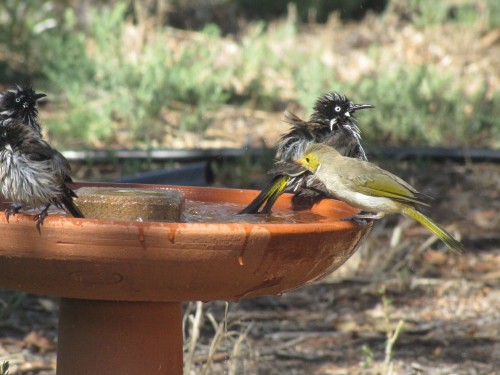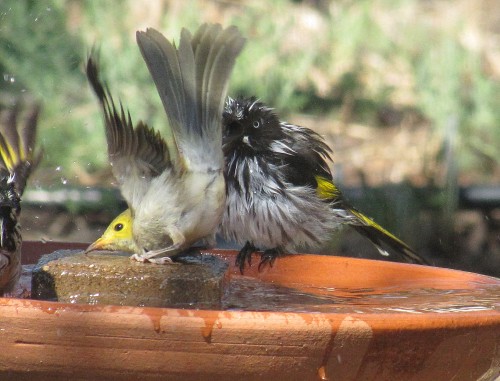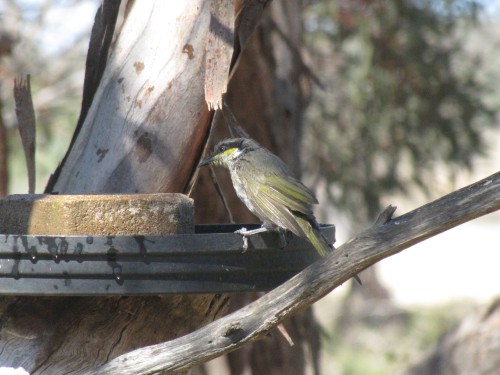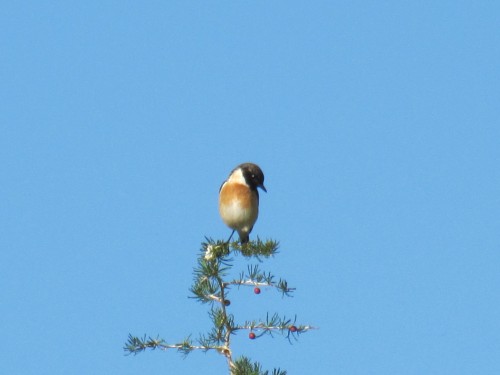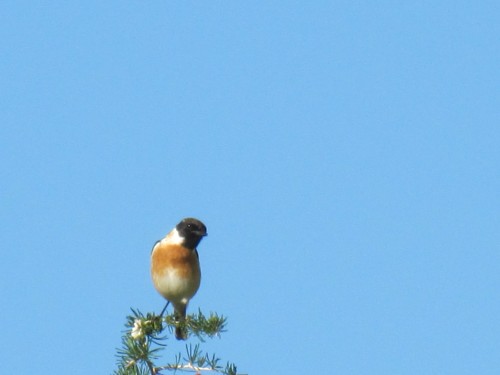White Plumed Honeyeater comes for a bath
Over recent days I have been writing about and showing photos of various birds coming to visit our birdbath. Usually the New Holland Honeyeaters dominate proceedings, making a terrible din and splashing water everywhere.
On this occasion a solitary White Plumed Honeyeater forced its way in , running the gauntlet of the mob. I am not sure what it is doing in the photo below. Almost seems like it has landed awkwardly. It’s probably just flapping its wings and I caught it in an unusual pose.
Singing Honeyeater at the birdbath
Yesterday I wrote about New Holland Honeyeaters bathing in our bird bath (click here to view that post).
While the New Hollands are by far the most frequent and noisiest of the visitors to the bird bath, many other species also come to bathe or drink during our hot spells in summer. The New Holland Honeyeaters may come individually, but they are more prone to come in a flock of a dozen or more. The result is usually very noisy – and water sprays everywhere.
By way of contrast, the Singing Honeyeater shown in today’s photo quite often comes alone, or at most, two. They tend to be far more solitary birds in our garden. They often wait a short distance away while other species drink, then slip in quietly to drink when calmness returns.
Hot weather birding
We are currently experiencing another heatwave. Tomorrow is forecast to be the 11th consecutive day over 30C; some of the days – like today – the temperature has reached 40C (104F). During such days I add a bucket of fresh rainwater to the various birdbaths we have in our garden. Several of them are in clear view of where we often sit to eat, or to enjoy some reading. Sometimes I even do my writing there; it gives me a break from my office and I have a different view. The camera is usually ready for action, so on occasions I neglect my writing and attend to some serious bird photography.
During the current heatwave the birds have been coming daily to drink, bathe and generally have a good time. The parade of species is impressive. We sometimes have up to a dozen different species come to drink in a 10 or 15 minute period. Last week I captured a series of photos of about a dozen New Holland Honeyeaters having a great time cooling off in the water. Droplets fly in all directions and some are left looking absolutely drenched.
For more photos like this one click here.
Review: Birds of North America
Review: Pocket Guide to the Birds of North America, National Geographic, March 2013.
Authors: Laura Erickson and Jonathan Alderfer.
I have been birding in a number of countries other than Australia and have generally enjoyed my experiences. On all of my trips, watching and photographing the local birds was secondary to being a tourist. One continent I would love to visit someday is North America. I was with this background then that I looked at this Pocket Guide.
When I do undertake my first trip to America, this handy pocket sized guide will be an essential part of my packing. Literally compact enough to fit in a pocket, it will not take up much room or weight in a backpack when touring and birding. While a complete field guide to the birds of North America would have to cover over 1000 species, this handy little book covers only 160 of the “most common and iconic” species.

Aimed at inexperienced birders, children and those who don’t want to carry a larger, heavier volume in the field, this is an ideal beginner guide. I dare say it would easily stimulate a greater interest in birds in anyone who has this book, being thorough, colourful and very easy to use. To assist these people, a handy Visual Index of the main bird families is on the inside front cover with another Quick Find Index inside the back cover.
Introductory section
To help beginner and inexperienced birders, as well as those with just a passing interest in birds, a very readable introductory section covers the following topics:
- Invitation to birding
- Why learn Bird Identification?
- Where to find birds
- Optics
- Using this filed guide (including a simple illustration of the parts of a bird)
- Taking it to the next level
Species entries
Each species represented in this guide has a dedicated page to it with the following entries:
- Common and scientific names
- A small map showing distribution
- a photograph of the bird in a typical pose
- a small sketch showing the bird perching (and flying if there are identifying features on the wings)
- a Key Facts sidebar
- A short descriptive text (usually about 100 words)
Some family groups also have an additional double page spread illustrating a dozen or more other species not included in the guide. These include pages on raptors, ducks, and sparrows.
Rating: 5/5 – this guide successfully and beautifully achieves all it sets out to do.
All I have to do now is save up for a trip to America.
Good birding.
Disclosure: I would like to thank National Geographic for kindly providing a review copy of this book.
For more information about this book, click here.
Common Redstart, Volubilis, Morocco
On route from Meknes to Fes on our tour of Morocco we stopped to inspect the ancient Roman ruins of Volubilis. This was a wonderful introduction to the oldest structures my wife and I have ever seen. It was fascinating, made even more significant in that it was one of many UNESCO World heritage Sites we visited during our tour of Morocco and Spain.
Because the ruins are in the countryside with farmland all around, I managed to see a few birds – in between absorbing the experience of seeing these amazing ruins and taking heaps of photos.
One of the first species I saw was this Common Redstart, a new species for me, that is, it was the first time I had seen this species in my life. It posed nicely for me in clear view. On this leg of the trip I didn’t have a field guide to help me identify the birds I saw. I relied on taking reasobale photos of the birds I saw. It was only when I arrived back home in Australia that I was able to find out the names of the birds seen during this part of our holiday. I must say that some have been a little hard tracking down. Most, however, are covered very well by online sites with good photos. It has enabled me to wander down memory lane time and again as I look at my shots, and remember all the highlights of the trip – of which there were many.
Note: this article was updated and new material added on 12th March 2016.
